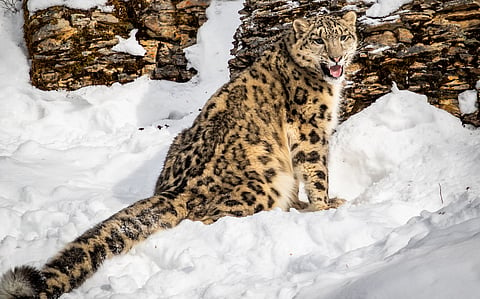

Snow leopards (Panthera uncia), the elusive big cats of High Mountain Asia, have very low genetic diversity, a new study led by Stanford University has found. This puts their future at risk.
Katie Solari, a research scientist in biology in Stanford’s School of Humanities and Sciences, along with Stanford biologist Dmitri Petrov and colleagues extensively collaborated with researchers and wildlife officials from 11 countries to come to the conclusion.
Because these cats live in highly inhospitable terrain, only four have been fully genetically sequenced before this study, a statement by Stanford noted. “This study brings that number to 41, including 35 wild snow leopards and six from zoos around the world,” it added.
The study findings indicate that snow leopards developed low genetic diversity from having a small, stable population over a long period of time.
In contrast, other big cat species, such as the cheetah and Florida panther, are believed to have experienced population crashes, what geneticists call a “bottleneck,” that led to their low genetic diversity.
Solari, Petrov and others found evidence that snow leopards not only had low genetic diversity, but also a significantly lower “homozygous load”. This means that when they inherited genes from each parent, there are fewer instances of them having duplicate copies of potentially harmful mutations.
“This suggests that over time, snow leopards had a periodic purging of bad mutations in their population: If a negative trait surfaced, those individuals died before reproducing or their progeny were less successful. This purging, facilitated by historic inbreeding, allowed the snow leopard population to remain relatively healthy even at their small numbers,” the statement said.
On the other hand, cheetahs, which once had very large populations, went through a bottleneck. They lost numbers and genetic diversity rapidly.
“Then, it was harder for them to thrive as more negative mutations were passed down among fewer individuals. Scientists believe cheetahs went through two population bottlenecks that led to their low genetic diversity today and many associated problems, including lower reproductive success and increased disease susceptibility,” according to the study.
All this may imperil the future of snow leopards.
“Because their habitat is so inhospitable, human population growth didn’t really affect snow leopards very much, but climate change will. Humans don’t need to show up in their mountains to build or start agriculture. The climate changes, and it affects everyone and everything, even in such remote areas,” the statement quoted Petrov as saying.
Exceedingly low genetic diversity in snow leopards due to persistently small population size was published on October 7 in the Proceedings of the National Academy of Sciences journal.
Snow leopards currently number an estimated 8,000 individuals across Asia.